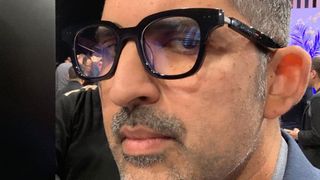First Look: Huawei smart eyewear
Ordinary-looking glasses fused with a Bluetooth headset

Along with the Huawei P30 and P30 Pro, the Chinese firm introduced a number of additional devices during its March 26 launch event in Paris, France, and its pair of smart glasses was a surprise "one more thing" announcement.
These glasses (or smart eyewear, as Huawei refers to them), are made in partnership with Korean fashion brand Gentle Monsters.
While 'smart' is in the name, don't expect anything on the level of Google Glass, as these glasses are simply equipped with a speaker and microphone.
Huawei smart eyewear release date and price
Huawei's smart eyewear release date is set for July 2019, but there's currently no word on how much they'll cost.
The tech inside seems simpler than the camera-toting Snap Spectacles, so we're hoping Huawei's specs come in comfortably cheaper.
Design
The idea of Huawei smart eyewear are they're glasses first and smart second, which means they look and feel like an ordinary pair of glasses.
In fact, the front frame that holds the lenses is non-smart, just like any other pair of glasses, with all the technology found in the side arms.
Get daily insight, inspiration and deals in your inbox
Get the hottest deals available in your inbox plus news, reviews, opinion, analysis and more from the TechRadar team.
There are no buttons, ports or visible sensors, which further aids their 'ordinary pair of glasses' aesthetic - and that's a good thing. Instead, you just tap the side of the glasses to answer calls or trigger Google Assistant (via a Bluetooth connection from your phone).
We tried a dummy pair at the P30 launch event and they felt just like a regular pair of glasses.
With a built-in microphone and speakers, these glasses serve the purpose of a Bluetooth headset without making you look dorky.

We can see how this could be useful for people that already wear glasses - if you like the look of them - to have an integrated headset.
There are a few varieties of frames with different styles and you can also purchase them as sunglasses.
That said the handful of samples that were available to try on were all pretty large, and those with smaller faces may feel like the glasses swamp them a little.
The glasses come with an IP67 dust and water resistant rating, which means they'll survive a rain shower if you're caught out.
You'll get a charging case with the glasses (similar to Snap Specs), allowing you to juice up your eyewear, and the case itself can either be wireless charged or plugged in via a USB-C port.

Listen up
When it comes to the tech that makes these glasses 'smart', you may be a little disappointed to find there's no tiny display or integrated camera.
Instead, you get a charging module, multiple antennas, dual mics, a chipset, a speaker and a battery packed into the arms of the glasses.
It would be interesting to see how they hold up in noisy environments, as Huawei is claiming that the tech is present for such scenarios with beam-forming and AI noise reduction coming to your aid.
We can't comment on how good they sound because the units at the demo area were dummies that couldn't be powered on.

Early thoughts
Future version of these glasses will probably add more tech but their sole function at the moment is recording or listening to audio.
The glasses do look good and feel good and we’re looking forward to testing them out once they’re released later this year.
Does this mark the start of a bigger push by Huawei into the smart eyewear arena? According to Huawei's VP of Global Product Marketing, Clement Wong, "never say never" - so you might want to watch this space.

John joined TechRadar over a decade ago as Staff Writer for Phones, and over the years has built up a vast knowledge of the tech industry. He's interviewed CEOs from some of the world's biggest tech firms, visited their HQs and has appeared on live TV and radio, including Sky News, BBC News, BBC World News, Al Jazeera, LBC and BBC Radio 4. Originally specializing in phones, tablets and wearables, John is now TechRadar's resident automotive expert, reviewing the latest and greatest EVs and PHEVs on the market. John also looks after the day-to-day running of the site.
